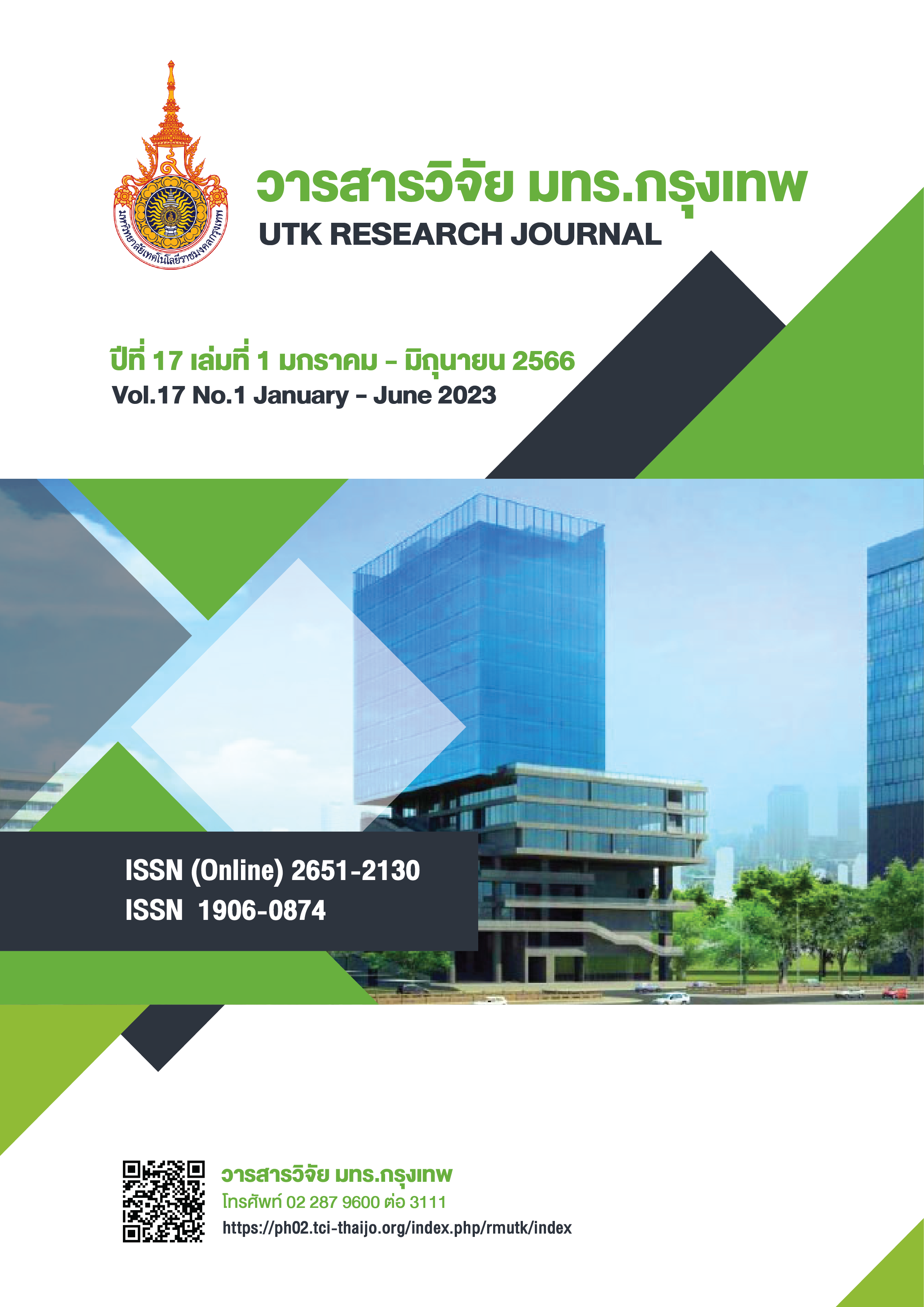ผลของสารสะท้อนน้ำต่อการพัฒนาผลิตภัณฑ์เชิงสร้างสรรค์จากผ้าไหมทอมือ
คำสำคัญ:
ผ้าไหมทอมือ, การตกแต่งสำเร็จสะท้อนน้ำ, การพัฒนาผลิตภัณฑ์บทคัดย่อ
งานวิจัยนี้มีวัตถุประสงค์เพื่อพัฒนาผลิตภัณฑ์กระเป๋าจากผ้าไหมทอมือที่ตกแต่งสำเร็จสะท้อนน้ำ ดำเนินการวิจัยโดยศึกษาสภาวะที่เหมาะสมและสมบัติของผ้าไหมทอมือที่ตกแต่งสำเร็จด้วยสารสะท้อนน้ำสองชนิด ได้แก่ สารสะท้อนน้ำฟลูออโรคาร์บอน (FC) และสารสะท้อนน้ำปราศจากฟลูออโรคาร์บอน (FCF) ออกแบบและผลิตต้นแบบผลิตภัณฑ์กระเป๋าจากผ้าไหมทอมือที่ตกแต่งสำเร็จสะท้อนน้ำ รวมทั้งศึกษาความพึงพอใจของผู้ตอบแบบสอบถามที่มีต่อผลิตภัณฑ์ดังกล่าว ผลการวิจัยพบว่าสภาวะที่เหมาะสมในการตกแต่งสะท้อนน้ำของสารทั้งสองชนิดเป็นสภาวะเดียวกัน คือ ใช้ความเข้มข้น 70 กรัมต่อลิตร บีบอัดผ้าด้วยลูกกลิ้งที่มีค่าร้อยละการบีบอัดเท่ากับ 75 อบแห้งที่อุณหภูมิ 120 องศาเซลเซียส เวลา 2 นาที ทำปฏิกิริยาที่อุณหภูมิ 165 องศาเซลเซียส เวลา 2 นาที ผ้าที่ตกแต่งด้วยสาร FCF มีสมบัติที่ดีกว่าผ้าที่ตกแต่งด้วยสาร FC ในเรื่องของการสะท้อนน้ำ ความเข้มสีบนผ้า และความคงทนต่อแรงฉีกขาด ส่วนผ้าที่ตกแต่งด้วยสาร FC มีสมบัติที่ดีกว่าผ้าที่ตกแต่งด้วยสาร FCF ในเรื่องความคงทนต่อการซัก โดยผ้าที่ตกแต่งด้วยสาร FCF มีค่ามุมสัมผัส 141.17 องศา ความเข้มสีบนผ้า 20.81 ความทนต่อแรงฉีกขาดในแนวเส้นด้ายพุ่ง 97.47 นิวตัน แนวเส้นด้ายยืน 63.6 นิวตัน มีความคงทนต่อการซัก 3 รอบ ส่วนผ้าที่ตกแต่งด้วยสาร FC มีค่ามุมสัมผัส 135.3 องศา ความเข้มสีบนผ้า 13.6 ความทนต่อแรงฉีกขาดในแนวเส้นด้ายพุ่ง 97.03 นิวตัน แนวเส้นด้ายยืน 60.57 นิวตัน มีความคงทนต่อการซักมากกว่า 5 รอบ ในการพัฒนาผลิตภัณฑ์กระเป๋าเลือกใช้สารสะท้อนน้ำประเภท FCF เนื่องจากเป็นผลิตภัณฑ์ที่ไม่ต้องการซักบ่อยครั้งและมีความเป็นมิตรต่อสิ่งแวดล้อมมากกว่า ผลการประเมินแบบความพึงพอใจในต้นแบบผลิตภัณฑ์จากผู้ตอบแบบสอบถามจำนวน 152 คน มีค่าเฉลี่ยความพึงพอใจต่อผลิตภัณฑ์กระเป๋าผ้าไหมทอมือที่มีสมบัติสะท้อนน้ำในระดับมาก โดยมีความพึงพอใจด้านความสวยงาม ด้านความเหมาะสมของวัสดุ ด้านประโยชน์การใช้สอย และด้านความสะดวกในการบำรุงรักษา เท่ากับ 4.43±0.76, 4.34±0.77, 4.38±0.74 และ 4.38± 0.75 ตามลำดับ
เอกสารอ้างอิง
Chang H, Tu K, Wang X, Liu J. Facile Preparation of stable superhydrophobic coatings on wood surfaces using silica-polymer nanocomposites. BioResources. 2015;10(2):2585–2596.
Ogihara H, Xie J, Okagaki J, Saji T. Simple method for preparing superhydrophobic paper: spray-deposited hydrophobic silica nanoparticle coatings exhibit high water-repellency and transparency. Langmuir ACS J Surf Colloids. 2012; 28(10):4605–8.
Chowdhury KP. Performance evaluation of water repellent finishes on cotton fabrics. Int J Text Sci. 2018;7(2):48–64.
Ghosh J, Islam MdR, Chakrabortty A. A qualitative analysis of different types of water repellent agent used on cotton fabric. Eur Sci J ESJ [Internet]. 2020 Feb 29 [cited 2021 May 29];16(6). Available from: http://eujournal.org/index.php/esj/article/view/12790
Lee HJ, Michielsen S. Preparation of a superhydrophobic rough surface. J Polym Sci Part B Polym Phys. 2007; 45(3):253–61.
Li ZR, Fu KJ, Wang LJ, Liu F. Synthesis of a novel perfluorinated acrylate copoly- mer containing hydroxyethyl sulfone as crosslinking group and its application on cotton fabrics. J Mater Process Technol. 2008;205(1):243–8.
Roe B, Zhang X. Durable hydrophobic textile fabric finishing using silica nanoparticles and mixed silanes. Text Res J. 2009;79(12):1115–22.
UNEP. POPS/PORC.15/7Add.1 Report of the persistent organic pollutants review committee on the work of its fifteenth meeting. [Internet]. 2019 [cited 2023 Feb 26]. Available from: http://chm.pops.
int/TheConvention/POPsReviewCommittee/Meetings/POPRC15/
Ahrens L. Polyfluoroalkyl compounds in the aquatic environment: a review of their occurrence and fate. J Environ Monit JEM. 2011;13(1):20–31.
Ahrens L, Gashaw H, Sjöholm M, Gebrehiwot SG, Getahun A, Derbe E, et al. Poly- and perfluoroalkylated substances (PFASs) in water, sediment and fish muscle tissue from Lake Tana, Ethiopia and implications for human exposure. Chemosphere. 2016;165:352–7.
Lam NH, Cho CR, Kannan K, Cho HS. A nationwide survey of perfluorinated alkyl substances in waters, sediment and biota collected from aquatic environment in Vietnam: Distributions and bioconcentration profiles. J Hazard Mater. 2017;323(Pt A):116–27.
จิรา คงปราณ. สารเพอร์ฟลูออโรอัลคิลและโพลีฟลูออโรอัลคิลกับการปนเปื้อนในสิ่งแวดล้อมของประเทศไทย. วารสารสาธารณสุขมหาวิทยาลัยบูรพา. 2561;13(2):151–67.
ASTM. ASTM D 7490-13: Standard test method for measurement of the surface tension of solid coatings, substrates and pigments using contact angle measurements. 2022. [cited 2023 Feb 26]. Available from: https://www.astm.org/d3776_d3776m-20.html
ASTM. Standard test methods for mass per unit area (weight) of fabric [Internet]. 2023 [cited 2023 Feb 26]. Available from: https://www.astm.org/d3776_d3776m-20.html
สำนักงานมาตรฐานผลิตภัณฑ์อุตสาหกรรม. มอก. 121 เล่ม 18-2553 แรงฉีกขาดของผ้าทอโดยใช้เครื่องทดสอบแบบเอลเมนดอร์ฟ [Internet]. 2023 [cited 2023 Feb 26]. Available from: https://service.tisi.go.th
/standard-shop/web/index.php?r=site
Samanta P. Basic principles of colour measurement and colour matching of textiles and apparels. Intechopen. DOI: 10.5772/intechopen.101442. [Internet] 2021. [cited 2023 April 2]. Available from: https://www.intechopen.com/chapters/80062
AATCC. AATCC 135 : Test Method for Dimensional Changes of Fabrics after Home Laundering [Internet]. 2018 [cited 2023 Feb 26]. Available from: https://global.ihs.com
Pandit S, Basuk M, Ruhela D, Bait S. Effect of curing temperature on development of water based polyurethane coated Polyester. 2018;5(4):967-973.
Güneşoğlu C, Kut D, Orhan M. Effect of the particle size of finishing chemicals on the color assessment of treated cotton fabrics. J Appl Polym Sci. 2007;104(4):2587–94.
ดาวน์โหลด
เผยแพร่แล้ว
รูปแบบการอ้างอิง
ฉบับ
ประเภทบทความ
สัญญาอนุญาต
ลิขสิทธิ์ (c) 2023 วารสารวิจัย มทร. กรุงเทพ

อนุญาตภายใต้เงื่อนไข Creative Commons Attribution-NonCommercial-NoDerivatives 4.0 International License.
กองบรรณาธิการวารสารวิชาการ มหาวิทยาลัยเทคโนโลยีราชมงคลกรุงเทพ มีความยินดีที่จะรับบทความจากอาจารย์ นักวิจัย นักวิชาการทั้งภายในและภายนอกมหาวิทยาลัย ในสาขาวิชาวิทยาศาสตร์และเทคโนโลยี ได้แก่ สาขาวิชาวิทยาศาสตร์ วิศวกรรมศาสตร์ และสาขาอื่นๆ ที่เกี่ยวข้อง รวมถึงสาขาต่างๆ ที่มีการบูรณาการข้ามศาสตร์ที่เกี่ยวข้องวิทยาศาสตร์และเทคโนโลยี ที่เขียนเป็นภาษาไทยหรือภาษาอังกฤษ ซึ่งผลงานวิชาการที่ส่งมาขอตีพิมพ์ต้องไม่เคยเผยแพร่ในสิ่งพิมพ์อื่นใดมาก่อน และต้องไม่อยู่ในระหว่างการพิจารณาของวารสารอื่น
การละเมิดลิขสิทธิ์ถือเป็นความรับผิดชอบของผู้ส่งบทความโดยตรง บทความที่ได้รับการตีพิมพ์ต้องผ่านการพิจารณากลั่นกรองคุณภาพจากผู้ทรงคุณวุฒิและได้รับความเห็นชอบจากกองบรรณาธิการ
ข้อความที่ปรากฏอยู่ในแต่ละบทความที่ตีพิมพ์ในวารสารวิชาการเล่มนี้ เป็นความคิดเห็นส่วนตัวของผู้เขียนแต่ละท่าน ไม่เกี่ยวข้องกับมหาวิทยาลัยเทคโนโลยีราชมงคลกรุงเทพแต่อย่างใด ความรับผิดชอบด้านเนื้อหาและการตรวจร่างบทความแต่ละบทความเป็นของผู้เขียนแต่ละท่าน หากมีความผิดพลาดใดๆ ผู้เขียนแต่ละท่านจะต้องรับผิดชอบบทความของตนเองแต่ผู้เดียว
กองบรรณาธิการขอสงวนสิทธิ์มิให้นำเนื้อหา หรือข้อคิดเห็นใดๆ ของบทความในวารสารวิชาการ มหาวิทยาลัยเทคโนโลยีราชมงคลกรุงเทพ ไปเผยแพร่ก่อนได้รับอนุญาตจากกองบรรณาธิการ อย่างเป็นลายลักษณ์อักษร ผลงานที่ได้รับการตีพิมพ์ถือเป็นลิขสิทธิ์ของวารสาร






